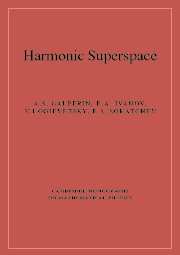Book contents
- Frontmatter
- Contents
- Preface
- 1 Introductory overview
- 2 Elements of supersymmetry
- 3 Superspace
- 4 Harmonic analysis
- 5 N = 2 matter with infinite sets of auxiliary fields
- 6 N = 2 matter multiplets with a finite number of auxiliary fields. N = 2 duality transformations
- 7 Supersymmetric Yang–Mills theories
- 8 Harmonic supergraphs
- 9 Conformal invariance in N = 2 harmonic superspace
- 10 Supergravity
- 11 Hyper-Kähler geometry in harmonic space
- 12 N = 3 supersymmetric Yang–Mills theory
- 13 Conclusions
- Appendix: Notations, conventions and useful formulas
- References
- Index
1 - Introductory overview
Published online by Cambridge University Press: 24 August 2009
- Frontmatter
- Contents
- Preface
- 1 Introductory overview
- 2 Elements of supersymmetry
- 3 Superspace
- 4 Harmonic analysis
- 5 N = 2 matter with infinite sets of auxiliary fields
- 6 N = 2 matter multiplets with a finite number of auxiliary fields. N = 2 duality transformations
- 7 Supersymmetric Yang–Mills theories
- 8 Harmonic supergraphs
- 9 Conformal invariance in N = 2 harmonic superspace
- 10 Supergravity
- 11 Hyper-Kähler geometry in harmonic space
- 12 N = 3 supersymmetric Yang–Mills theory
- 13 Conclusions
- Appendix: Notations, conventions and useful formulas
- References
- Index
Summary
We start by overviewing the origins, motivations, basic ideas and results of the harmonic superspace (and space) approach. Our major aim here is to give the reader a preliminary impression of the subject before immersion into the main body of the book.
Brief motivations
It is hardly possible to overestimate the rôle of symmetries in the development of physics. The place they occupy is becoming more and more important every year. The very family of symmetries is getting richer all the time: Besides the old symmetries based on Lie algebras we are now exploiting new kinds of symmetries. These include supersymmetries which mix bosons with fermions and are based on superalgebras, symmetries associated with non-linear algebras of Zamolodchikov's type, symmetries connected to quantum groups, etc. To date, the supersymmetric models have been studied in most detail. They turn out to have quite remarkable features. They open a new era in the search for a unified theory of all interactions including gravity. They help to solve the hierarchy problem in the grand unification theories. For the first time in the history of quantum field theory, supersymmetry has led to the discovery of a class of ultraviolet-finite local four-dimensional field theories. In these finite theories the ultraviolet divergences in the boson and fermion loops ‘miraculously’ cancel against each other. Supersymmetries underlie the superstring theories, which provide the first consistent scheme for quantization of gravity.
- Type
- Chapter
- Information
- Harmonic Superspace , pp. 1 - 26Publisher: Cambridge University PressPrint publication year: 2001
- 3
- Cited by



